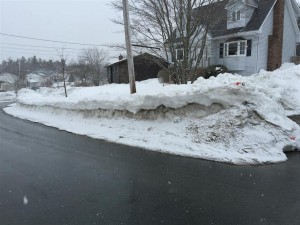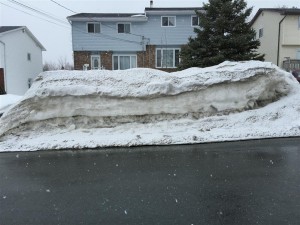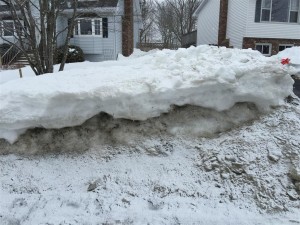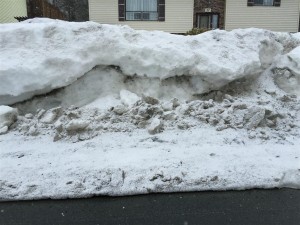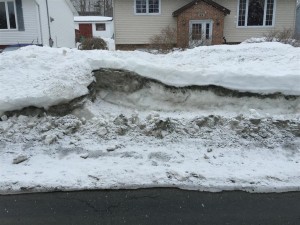You might be interested in an article by a U.S. civil litigation lawyer on the use of aerial photographs in environmental litigation – see Appendix. I came across it while researching material for a forensic engineering investigation that I was carrying out.
References at the end of the article in the Appendix might be of interest to civil litigation lawyers in eastern Canada.
The article is quite descriptive and detailed. It possibly claims a bit more potential for these types of high altitude aerial photographs taken from 1,000s of feet than is actually the case, but the claim is close to reality.
For certain, all the claims for high level aerial photographs do apply to the low level aerial photographs taken with drones at 10s to 100s of feet that I noted recently. (Refs 1 to 4) I’ve used both high and low level aerial photographs in my civil, geotechnical and forensic engineering work for years.
Following are a few non-technical comments on aerial photographs to help you know if the method is applicable to your case:
High level aerial photography
This type of high altitude aerial photography is readily available everywhere in north America.
The ground is photographed from aircraft flying at altitudes of several 1,000s of feet. You get photographs of quite extensive areas – 1,000s of feet across. However, you can sometimes identify quite small objects as mentioned in the article in the Appendix. You can also view a site in 3D with overlapping pairs of photographs.
The civil engineer/former land surveyor in me does not usually go on the site of an engineering failure or problem without first getting this type of photography. I got it most recently for a site in Cape Breton, N.S.
The high altitude photography has particular application to tracking changing conditions on the ground over time or the conditions at a site at some point in the past. Like the activity on a site as noted in the article.
On one occasion, I relied on high level photography during the forensic investigation of the inadequate underpinning of a structure – to confirm what was not there.
Lidar
Lidar (Light, Radar), another form of high level remote sensing from an aeroplane, is not so readily available but invaluable when it is. It measures distance by illuminating a target – e.g., a point on the ground, with a laser and analysing the reflected light. Radar measures the location of the point. A gazillion points are illuminated and measured and a contoured topographic map produced.
It was very valuable during my investigation of a failure in Sydney. The site had flooded, a building had settled and the foundations cracked, and a swimming pool had settled a lot – catastrophically. Lidar imagery clearly showed the probable cause of the flooding and settlement – from an altitude of several 1,000s of feet. This was one of the most satisfying experiences I’ve had using remote sensing technology to investigate the cause of a failure.
Low level photography with drones
This type of low altitude photography is readily available in eastern Canada and at reasonable cost. The drones consist of rotorcraft – mini helicopters, and small, fixed wing aircraft fitted with a camera. The craft are a few feet in size. They are flown remotely by a pilot on the ground. The investigating engineer directs the pilot on the photographs and video to take. That is, the altitude above the site, the distance from the site and the angle with respect to the horizon, also whether still or video.
Photographs taken from drones flying at metres to 10s of metres are able to record existing conditions in considerable detail – almost minute, at the time of the flight. It is easy to see an object six inches across – even a toonie, in such photographs. Low level photography produces images of very compact sites – 10s to 100s of metres across.
It can also be used today to start building a photographic record of changing site conditions for study and analysis in the future.
Low level aerial photographs taken from drones would have been quite useful in the forensic investigation of the bridge that failed while under construction in Edmonton earlier this year. (Refs 5 and 6)
Before drones fitted with cameras were available, I occasionally hired small planes to fly over a site and take photographs at quite low levels – several 100s of metres. I occasionally went aloft in the plane myself.
This technique was quite valuable to me in solving problems with a sewage lagoon in the Annapolis Valley in Nova Scotia one time. From above, you could easily see the line of seepage where the lagoon was leaking.
In both low and high altitude photography, and the study, analysis, and interpretation of the images of what’s on the ground – known as ‘terrain analysis’ – ground proofing is essential. (Ref. 7) This involves going on the site and checking at selected locations that what you thought you saw in the photographs is actually on the ground.
***
There’s a lot of sophisticated aerial photographic techniques being used in forensic investigation today. I’m using them in eastern Canada, and they are getting good use in the U.S. as indicated in the article in the Appendix.
But, at the end of the day, an expert has to get on site and “get his hands dirty and mud on his boots” examining the site in detail – something more than the ground proofing noted above. (Ref. 8)
References
- A picture is worth a 1,000 words, possibly many 1,000s in forensic engineering with a new aerial photographic technique. Posted January 15, 2014
- New forensic aerial photographic method proving extremely valuable. Posted January 30, 2015
- Forensic photography – the expertise available in eastern Canada. Posted February 26, 2015
- Fixed wing drones – another tool in forensic engineering investigation. Posted November 4, 2015
- Globe and Mail page A8 Tuesday March 17, 2015, “Buckled girders may delay Edmonton bridge a year”
- Wind, construction crane and inadequate cross-bracing caused Edmonton bridge failure: An initial hypothesis. Posted March 27, 2015
- Way, Douglas S., Terrain Analysis: A guide to site selection using aerial photographic interpretation, 2nd edition, 1978, McGraw Hill, New York
- An expert’s “dirty hands and muddy boots”. Posted December 20, 2013
Appendix
Using Aerial Photography to Win Environmental Cases by Kim K. Burke
June 7, 2011
Most environmental lawyers and consultants are first introduced to aerial photographs when reviewing Phase I Environmental Site Assessments (ESA) prepared in accordance with ASTM E-1527-05. However, the use of aerial imagery in Phase I ESA reports to determine historical site conditions barely scratches the surface of the effective use of aerial photography.
Aerial photography, also referred to as aerial imagery (as a component of remote sensing), is a potent tool for environmental trial lawyers. Databases of aerial photographs from 1938 are readily available through aerial photography clearinghouses.
The photos are usually taken with a high resolution camera using overlapping images. The overlapping images are called “stereo pairs” and when viewed as “diapositives” through a stereoscope on a light table produce a three dimensional image of the surface features: buildings, drainage patterns, ravines, containers, tanks, vehicles, mounds, etc. Vertical and horizontal surface features can be measured, depending on the quality of the photographs.
Aerial photography interpretation can be used in conjunction with geographic information systems (GIS) to develop trial exhibits recreating site conditions at the time of important historic environmental events.
Accurate aerial photography interpretation is a critical component of environmental forensics. The stereo pairs should be interpreted by a seasoned imagery analyst trained in environmental remote sensing. Many analysts are former employees of the military or the U.S. government.
Finding a qualified environmental imagery analyst is difficult, because the telltale signs or marks on the aerial photographs of ground level activity, referred to as “signatures,” are different for 55 gallon drums or former burial pits than, for example, intermediate range ballistic missiles.
Stereo pairs are usually shot by aircraft when cloud and vegetative cover are at a minimum (excepting aerial imagery by agencies analyzing crop growth).
Some aerial photos are taken using cameras that detect ranges of the electromagnetic spectrum not visible to the human eye, such as infrared signatures.
The detail can be stunning: some aerial images permit identification of features as small as six inches, and in some cases permit license numbers to be read on vehicles when taken from low-altitude oblique angles.
Collecting and analyzing the historical library of aerial imagery is not a task for most environmental consultants. Specialists can call upon not only the more widely used public sources of aerial photographs, but also upon databases of lesser-known aerial photography companies that operate on a regional basis.
Because of the incredible detail and information that can be extracted from stereo positives viewed through a stereoscope on a light table (a table that projects diffuse light from underneath the positive images into the stereoscope), it is usually a mistake to order “prints” from the public resources offering to sell historical aerial photos.
To say that aerial photography can be a game changer in environmental cases is an understatement: in one case handled by this firm, the historical aerial photographs showed trucks tipped to dump waste into a ravine…a fact denied by the prior owner of the real property.1 The case settled shortly after sharing these photos with the responsible party.
Juries are intrigued and persuaded by visual and scientific evidence…sometimes known as the “CSI effect.”2 This law firm has used the testimony of experts interpreting environmental signatures on historic aerial photographs.3 The impact on jurors (and judges)4 can be profound.
Environmental attorneys and consultants not trained in aerial photography signature interpretation can miss important clues about past uses of the property.5
The photographs can also be used during, or after, witness interviews to test the accuracy of a person’s memory.
Of course, aerial photographs provide an excellent means of impeaching the credibility of opposing witnesses who testify with professed certainty about different historic site features.
For more information about the effective use of aerial photographs in environmental cases, please contact Kim Burke or any member of the Taft Environmental Practice Group.
References
1Burke, Kim K., The Use of Experts in Environmental Litigation: A Practitioner’s Guide, 25 N.Ky.Law Rev. 111 (1997).
2Lawson, Tamara F., Before The Verdict and Beyond the Verdict: The CSI Infection Within Modern Criminal Jury Trials, 41 Loy.U.Chi.L.J. 119 (Fall 2009).
3Stout, Kristen K. and Hickerson, Glen H., Environmental Research, Inc., The Use of Aerial Photography to Determine Contamination Events at Agricultural Chemical Facilities, Proceedings before the American Academy of Forensic Sciences, Colorado Springs, CO (Feb. 2003).
4Nutrasweet Company v. X-L Engineering Company, 227 F.3d 776, 788 (7th Cir. 2000)(expert testimony interpreting aerial photographs admissible to show history of site contamination).
5Burke, Kim K., 1999 Annual Meeting, American Academy of Forensic Sciences: Experts and Attorneys in Environmental Litigation: Avoiding Common Mistakes, Coronado Springs Resort, Orlando, FL.

